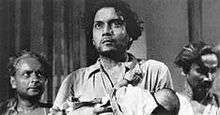Chinnamul
Chinnamul (Bangla: ছিন্নমূল, alternate spelling Chhinnamul, The Uprooted) was a 1950 Bengali film directed by Nemai Ghosh.[1][2] This was the first Indian film that dealt with the partition of India. The story revolved around a group of farmers from East Pakistan (now Bangladesh) who were forced to migrate to Calcutta because of the partition of Bengal in 1947.[3] Russian film director Vsevolod Pudovkin came to Calcutta at that time, watched this film, and being inspired, he bought the print of this film to release in Russia. The film was shown in 188 theaters in Russia.[4]
| Chinnamul | |
|---|---|
 A scene from the film Chinnamul | |
| Directed by | Nemai Ghosh |
| Story by | Swarnakamal Bhattacharya |
| Starring | Gangapada Basu Bijon Bhattacharya Ritwik Ghatak Shobha Sen |
| Music by | Kalabran Das |
| Cinematography | Nemai Ghosh |
Release date | 1950 |
Running time | 117 minutes |
| Country | India |
| Language | Bengali |
Plot
The film is based on a story of Swarnakamal Bhattacharya. Depicting the physical pain and crisis, the film is about the partition of Bengal and the flow of refugees from East Pakistan (present Bangladesh) into India. The story of the film begins in a village of East Bengal where people (Hindus and Muslims) live peacefully. Govinda and Sumati are husband wife and they are about to have a child. But, the partition forces Hindu people to leave their ancestral village. So, they become refugee. They don't find any location or shelter in Calcutta and eke out their daily lives in temporary shelters in and around Sealdah railway station. Along with millions of refugees the family has to face untold misery in big city.[5]
Cast and crew
Cast
- Gangapada Basu
- Bijon Bhattacharya
- Jalad Chatterjee
- Shanta Devi
- Ritwik Ghatak
- Shanti Mitra
- Prematosh Roy
- Shobha Sen
- Sushil Sen.
Crew
- Direction and cinematography: Nemai Ghosh.
- Writer: Swarnakamal Bhattacharya.
- Music: Kalabran Das
See also
References
- Indu Ramchandani (2000). Students' Britannica India: Select essays. Popular Prakashan. p. 101. ISBN 978-0-85229-762-9. Retrieved 23 June 2012.
- Laura E. Ruberto; Kristi M. Wilson (2007). Italian Neorealism and Global Cinema. Wayne State University Press. p. 81. ISBN 978-0-8143-3324-2.
- "The Uprooted (1950)". New York Times. Retrieved 3 August 2012.
- "Chinnamul" (in Bengali). Retrieved 10 March 2012.
- Anjali Gera Roy (2008). Partitioned lives : narratives of home, displacement, and resettlement. New Delhi : Dorling Kindersley (India). p. 67.